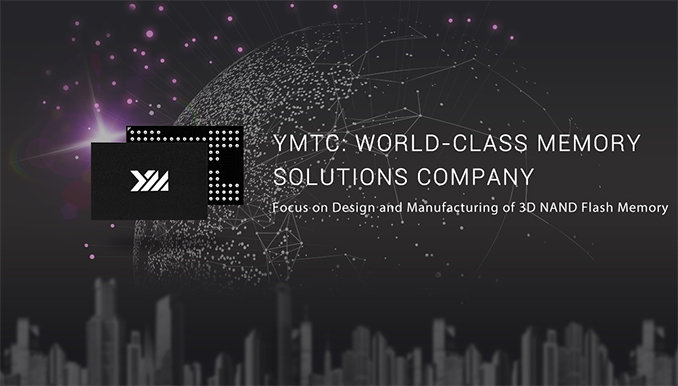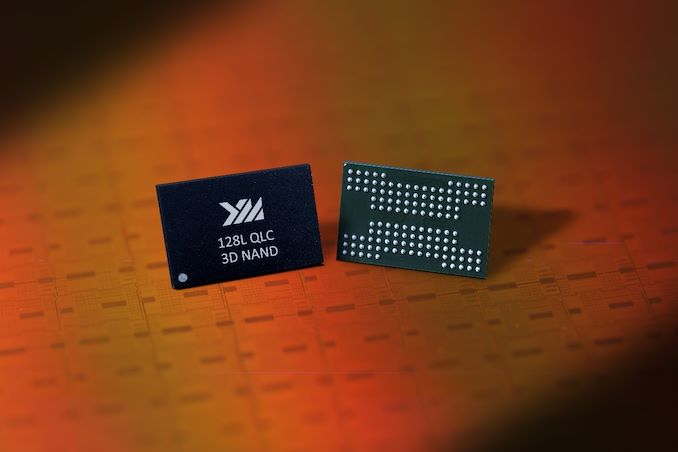China Develops High Capacity QLC 3D NAND: YMTC at 1.33 Tb
by Gavin Bonshor on April 13, 2020 11:00 AM EST
Yangtze Memory Technologies Co. (YMTC) has announced that it's developed its new 128-layer 1.33 Tb QLC 3D NAND memory chip, the X2-6070. The new chip is based on its Xtacking architecture which enables it to run with super high I/O while maximising the density of its memory arrays. YMTC has also unveiled its plan for a 128-layer 512 Gb TLC chip, the X2-9060, designed to meet more diverse application requirements.
We first reported on the China-based company YMTC entering its 3D NAND memory chips into production back in 2018, when it unveiled its Xtacking Architecture at the Flash Memory Summit. While it didn't disclose technical details of its announcement, it did state the Xtacking architecture has the capability to run the I/O with speeds of up to 3 Gbps. Fast forward to 2019, and it announced that it planned to start volume production of its 64-layer 3D NAND which we also reported on.
Using its Xtacking architecture at the forefront of production, both the new X2-6070 and X2-9060 feature its updated 2.0 variant which YMTC claims to bring more benefits to flash memory. Both the X2-6070 and X2-9060 are claimed to deliver up to 1.6 Gb/s of I/O performance and operate with a Vccg voltage of 1.2 V. YTMC has stated that the X2-6070 QLC based chip will be first used in consumer-grade SSDs, with the aim to then deliver its capabilities into Enterprise focused drives.

YMTC X2-6070 128-Layer QLC 3D NAND memory chip
The QLC based X2-6070 has 128-layers and more than 366 billion effective charge-trap memory cells. Each memory cell has 4-bit of data, which equates to 1.33 Tb of storage capacity. Everything is proportionate to cost, and it seems like YMTC, which is newer than most to 3D NAND stacking, could again improve its Xtacking architecture in the future.
We expect that YMTC, who is part of the Tsinghua Unigroup in China, is using the XMC fab in Wuhan China to produce its wafers for its 3D NAND. Tsinghua acquired XMC back in 2016, and while we haven't had it confirmed, it is likely to be producing its wafers at the XMC fab, which is one of China's largest semiconductor fabrication plants which also uses the Xtacking architecture.
YMTC hasn't released official specifications or data sheets about the X2-6070 QLC and X2-9060 MLC memory chips, nor has it stated when it is likely to be integrated with its controller partners (or which controllers support it).
Related Reading
- Yangtze Memory Unveils Xtacking Architecture for 3D NAND: Up to 3 Gbps I/O
- Flash Memory Summit 2018, Yangtze Memory Technology Keynote Live BlogL Unleashing 3D NAND
- YMTC Starts Volume Production of 64-Layer 3D NAND
- SK Hynix Sampling New PCIe 4.0 96L SSDs, 128L 4D NAND Enterprise SSDs
- Micron to Start Volume Production of 128-Layer 3D NAND with RG Architecture This Quarter










64 Comments
View All Comments
eek2121 - Monday, April 13, 2020 - link
My 120gb SSD with a sandforce controller disagrees.Hul8 - Tuesday, April 14, 2020 - link
You've had it sitting on a shelf for well over a year, and checked that every bit is still as it should be?Freeb!rd - Tuesday, April 14, 2020 - link
I heard it could be only a few months before data loss could start to occur. I don't have any QLC SSDs yet, but I've been wondering the same thing. I can probably pull data off an old 10GB IDE Maxtor drive with some ancient parts in the basement, not sure these would do that.Found the article I read before, it says to stay away from enterprise drives...
https://www.extremetech.com/computing/205382-ssds-...
29a - Sunday, April 19, 2020 - link
I've been using a QLC SSD since Nov 2018 with no issues.bansheexyz - Monday, April 13, 2020 - link
Please consider that drive size increases are constantly mitigating this until it no longer matters at consumer-level. In other words, the more cells you have to spread writes across, the more meaningless individual cell endurance becomes. Once QLC drives reach 12TB, the TBW of such a drive will be double what a 2TB TLC drive is now. Which you consider to be good and safe for 10 years, right? The average person also greatly overestimates how much writing they actually do. Most people probably don't even dip below 80% durability before upgrading.deil - Tuesday, April 14, 2020 - link
1000 writes is FULL DISK WRITE for a YEAR 3 TIMES A DAY. And that's guaranteed, then you will slowly loose over provisioning. this drive will survive most users, and as cappacity is ~40x when we seen SLC drives, also FULL DISC WRITE means 40x as much data.if you download and delete COD:MW from steam 12 times a day, you will kill 480 GB drive, in a YEAR.
QLC for most people is good enough, really. Only requirement is to have the drives bigger.
nandnandnand - Monday, April 13, 2020 - link
1.33 Tb is the highest capacity die size that has been announced by a manufacturer, correct? I recall that Western Digital announced 1.33 Tb, and maybe one other company.MrSpadge - Monday, April 13, 2020 - link
Yes.nandnandnand - Monday, April 13, 2020 - link
Thanks. It looks like WD mentioned 1.33 Tb dies in 2018. I'm surprised we haven't heard anything about 1.5 Tb or greater yet.https://www.anandtech.com/show/13102/western-digit...
Billy Tallis - Tuesday, April 14, 2020 - link
For now, decreasing the die size and cost is generally preferable to increasing per-die capacity. With the latter strategy, you have to compensate for lost performance by splitting the die into a larger number of planes and running the IO interface at a higher speed. YMTC's Xtacking design is intended to enable this in a more cost-effective way, so eventually it should enable things like a 4-channel SSD using 2Tb dies with comparable performance to current 8-channel SSDs using 1Tb or 512Gb dies. But controllers aren't ready for much faster NAND interface speeds and price per GB is high enough that the market still needs low-capacity dies for <512GB SSDs and smartphones.